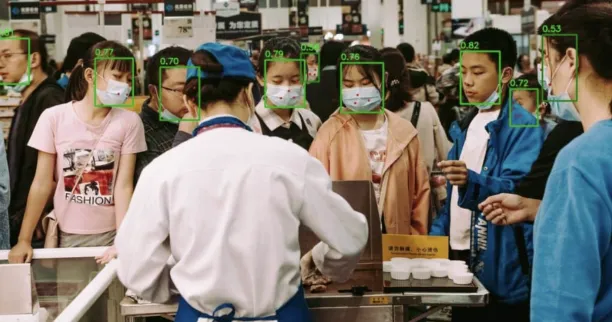As global crime rates rise, the demand for scalable and efficient security solutions is growing. The market is projected to reach $39 billion by 2029, growing at a CAGR of approximately 10% from 2025 to 2029.1
Conventional manual surveillance is limited by human capacity; personnel can only monitor footage for short periods with inconsistent accuracy. This raises a key challenge for providers: how to scale operations while managing personnel costs.
To meet these demands, security leaders are adopting AI technologies, such as computer vision, which can enhance accuracy, automate monitoring, and improve efficiency.
Explore the top 5 applications in computer vision security that can help businesses implement this technology in their operations.
Computer vision security use cases
1. Facial recognition for criminal identification
Person detection refers to the ability of computer vision systems to identify human presence within video feeds. It is a fundamental task in computer vision security, supporting various higher-level functions, such as access control, real-time threat detection, and identity verification.
At airports, surveillance cameras enhanced with person detection are used at security checkpoints to track movement patterns. If a person enters a restricted area, the system detects the breach and alerts security personnel for immediate intervention.
Using computer vision algorithms, person detection enables automated systems to monitor large premises, such as data centers and public venues, with minimal human intervention. This use case directly contributes to reducing false alarms by filtering out irrelevant motion, including animals or shadows.
Real-life example:
Visionify implemented a computer vision system to monitor restricted zones within industrial sites. The system utilized facial recognition and motion detection to identify unauthorized personnel entering sensitive areas.
Upon detection, real-time alerts were sent to security teams, enabling them to respond immediately and prevent potential security breaches.2

Figure 1: An example from Viso.ai on crowd face detection with computer vision and deep learning models.3
2. Detection of violent behavior and threats
Dangerous situation detection involves identifying events that pose a threat to safety, such as fire outbreaks, physical altercations, or hazardous material spills. This application of computer vision in security plays a critical role in supporting emergency protocols and safety regulations.
In industrial plants, computer vision technology is deployed to detect whether workers are wearing personal protective equipment (PPE). If a person is detected without a hard hat or safety vest in a designated area, the system flags the violation and alerts supervisory staff.
Visual data is continuously analyzed to identify anomalies, enabling real-time threat detection and faster emergency response. The technology relies on deep learning models trained to recognize context-specific dangers with minimal need for manual intervention.
3. Theft and fraud prevention
Computer vision provides powerful tools for detecting suspicious activities related to theft and fraud. These systems are widely adopted in the retail sector, financial institutions, and warehouses to secure both physical and financial assets.
Retailers use surveillance cameras connected to AI-based computer vision systems to detect unusual behavior, such as repeated hand movements toward high-value items or bypassing checkout counters. These systems help reduce shoplifting and internal theft.
In banks, computer vision applications such as facial recognition and behavioral analysis are used to flag identity mismatches or unauthorized access attempts. Automated monitoring systems can alert security teams when a person’s behavior deviates from known customer patterns.
Real-life example:
Laurel Ace Hardware in Oakland, California, faced significant losses due to shoplifting. By integrating Veesion’s AI software with existing surveillance cameras, the store could analyze customer movements to detect suspicious behaviors indicative of theft. This implementation led to a 50% reduction in shoplifting incidents.4
4. Crowd disaster prevention
Crowd disaster prevention involves monitoring dense gatherings to detect patterns that may lead to stampedes, overcrowding, or riots. It is a key application in the security industry for public events, transit hubs, and stadiums.
During large events, computer vision systems installed on multiple cameras track crowd density and flow. If people begin to cluster excessively near exits or barriers, the system detects the anomaly and recommends immediate crowd control actions.
These systems utilize object detection and pedestrian detection to analyze video data and ensure compliance with safety regulations. Law enforcement agencies and emergency teams rely on such monitoring systems for rapid response during festivals, political rallies, or crisis events.
Real-life example:
A government-affiliated organization managing large-scale public events adopted Viso Suite to improve crowd safety and operational efficiency. Traditional monitoring methods lacked the speed and accuracy needed to detect potential threats such as congestion, falls, or individuals moving against designated routes.
The organization required a scalable solution capable of analyzing real-time video feeds from hundreds of existing cameras, identifying anomalies, and delivering immediate alerts to security teams.
Using computer vision systems built on Viso Suite, the organization achieved a 20% reduction in safety incidents, a 15% drop in wait times, and improved attendee experience.
The technology enabled proactive decision-making and compliance with safety regulations while supporting future scalability.5
5. Enhanced security training via surveillance data
Safety training is enhanced by utilizing recorded video feeds analyzed by computer vision technology to identify unsafe practices and improve operational efficiency. This helps organizations update their training protocols based on actual incidents and behavioral patterns.
Logistics companies use computer vision to review employee behavior in warehouses. If a person regularly lifts objects incorrectly, the system flags the violation. These clips are then used during training sessions to illustrate risky behaviors and compliance gaps.
By integrating computer vision systems into training workflows, organizations can develop data-driven safety programs that accurately reflect real operational environments. This approach facilitates continuous improvement in security infrastructure and reduces the likelihood of workplace accidents.
Real-life example:
Rapid Innovation offers customized solutions that enhance workplace safety, resulting in increased employee morale and reduced operational expenses.
One key initiative involves upgrading safety training programs through the use of virtual reality (VR) and augmented reality (AR). These technologies create immersive learning environments that enable employees to better understand safety protocols.
By adopting advanced training tools, organizations can reduce training durations and enhance the retention of critical safety practices.6
Challenges of computer vision security and best practices
Accuracy limitations in complex environments
Computer vision systems may struggle with accuracy when dealing with poor lighting, occlusion, or crowded scenes. For instance, object detection and person detection can be affected by shadows, overlapping bodies, or unexpected obstructions. These limitations can lead to misclassifications and a failure to detect potential threats.
Best practices:
Enhancing computer vision algorithms with deep learning models trained on diverse datasets can improve detection reliability. Integrating thermal imaging with surveillance cameras and applying advanced image preprocessing techniques can help maintain accuracy in low-visibility conditions.
Additionally, monitoring systems should be periodically retrained with updated visual data to reflect changes in the physical environment.
High rate of false alarms
One of the persistent issues in computer vision for security is the generation of false alarms. Systems may flag harmless activities as potential threats due to overly sensitive settings or a limited understanding of context. This undermines trust and diverts attention from genuine threats.
Best practices:
Using anomaly detection models that incorporate context-aware learning can reduce the number of false positives. Incorporating data from multiple cameras and cross-referencing inputs enhances the precision of threat detection.
Employing AI-based computer vision solutions with feedback loops from security personnel helps refine detection logic over time.
Privacy concerns and regulatory compliance
Deploying computer vision applications, especially those involving facial recognition, often raises privacy concerns. These concerns are particularly acute in public areas or within organizations subject to strict data protection regulations.
Best practices:
Security systems should adopt privacy-by-design principles, limiting the use of biometric authentication to authorized personnel only and anonymizing visual data where feasible. Organizations must comply with safety regulations and implement transparent policies regarding the use of facial recognition technology and access control systems.
Integration with legacy infrastructure
Many organizations still rely on traditional security systems that were not built for AI-based integration. Upgrading to computer vision technology requires alignment with existing cameras and backend tools, which can create compatibility and cost challenges.
Best practices:
Deploying modular solutions that can integrate with existing cameras and monitoring systems is crucial. Computer vision offers plug-in architectures that enable gradual adoption without requiring the replacement of the entire security infrastructure.
Edge computing devices can also process video feeds locally, reducing the need for overhauling backend systems.
Demand for real-time processing and scalability
Computer vision security applications, especially those involving threat detection at critical infrastructure or large venues, require low-latency processing and high scalability. Delays in analyzing video feeds compromise rapid response and limit the effectiveness of automated systems.
Best practices:
Implementing edge-based computer vision systems minimizes latency by processing data near the source. Scalable cloud architectures, supported by advanced algorithms, enable high-throughput video data analysis across multiple cameras. These approaches support real-time threat detection, improving operational efficiency for security teams.
External Links
- 1. Security - Worldwide | Statista Market Forecast. Statista
- 2. Enhancing Security with AI-Powered Person Detection | Computer Vision | Visionify. Visionify Inc.
- 3. Face detection: a guide to deep learning applications - viso.ai. viso.ai
- 4. Retail theft keeps rising in the Bay Area. Can AI help stop thieves?. San Francisco Chronicle
- 5. Major Annual Event Strengthens Crowd Safety with Visual AI - viso.ai. viso.ai
- 6. Transforming Safety with Computer Vision Solutions. Rapid Innovation


Comments
Your email address will not be published. All fields are required.